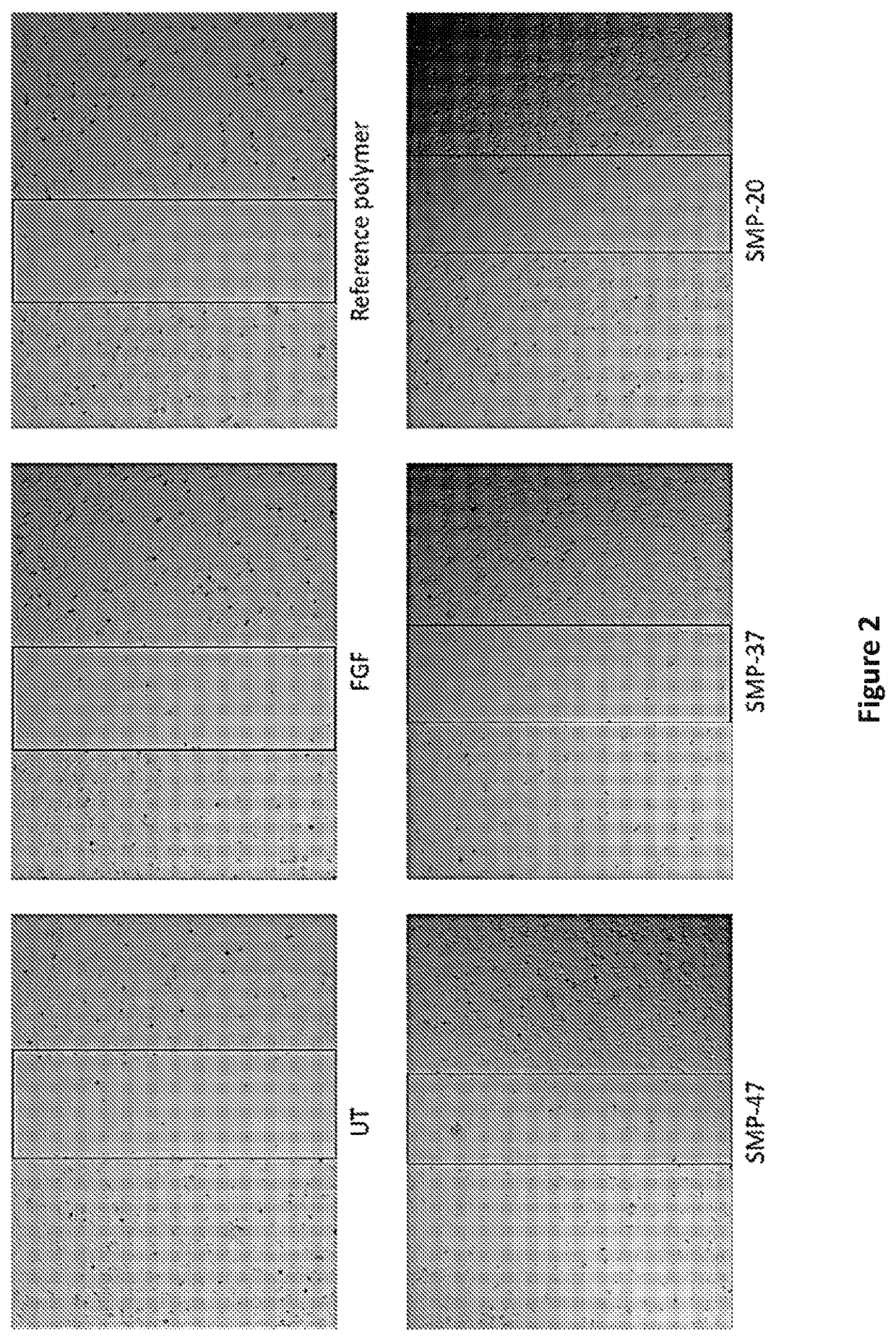Compounds, compositions and methods related to antimicrobial applications
a technology of antimicrobial applications and compositions, applied in the field of compounds, can solve the problems of increased hospitalization time, significant patient morbidity, and high sensitivity of surgical instruments to bacterial and fungal infections, and achieve the effects of reducing the risk of infection, and improving the duration of hospitalization
- Summary
- Abstract
- Description
- Claims
- Application Information
AI Technical Summary
Benefits of technology
Problems solved by technology
Method used
Image
Examples
example 1
[0213]Synthesis of Compounds SMP-002, SMP-046 and SMP-047
[0214]di-tert-Butyl (azanediylbis(propane-3,1-diyl))dicarbamate (1): 1,1′-Carbonyldiimidazole (CDI) (13.60 g, 84 mmol) was suspended in a mixture of toluene (100 ml) and t-butanol (11.91 g, 15 ml, 161 mmol) under nitrogen atmosphere and was heated to 60° C. for 5 h. A solution of norspermidine (5.77 g, 6.2 ml 44 mmol) in toluene (60 ml) was added dropwise. The reaction mixture was refluxed at 120° C. for 18 h, then cool and concentrated under vacuum. The resulting liquid was extracted in dichloromethane, washed with distilled water and finally dried over anhydrous Na2SO4, filtered and concentrated in vacuo to give di-tert-butyl (azanediylbis(propane-3,1-diyl))dicarbamate as a white powder (12 g, 86%). 1H NMR (CDCl3): δ 5.22 (brs, 2H, —NHCO), 3.21-3.10 (m, 4H, —CH2NHCO), 2.63-2.60 (m, 4H, —CH2NH), 1.65-1.59 (m,4H, —CH2), 1.40 (s 18H, C(CH3)3).
[0215]N-Acetyl-S-dodecyl-L-cysteine (2): Freshly cut sodium metal (180 mg, 7.8 mmol) w...
example 2
[0224]Synthesis of Compound SMP-022
[0225](tert-Butoxycarbonyl)-L-cysteine (8): A mixture of L-cysteine hydrochloride (1.23 g, 8.25 mmol), (Boc)2O (1.801 g, 8.25 mmol) and NaHCO3 (2.5 g, 29.8 mmol) in THF (7 mL) and water (18 mL) was stirred under argon at room temperature for 30 hours under nitrogen atmosphere. After completion of the reaction pH was adjusted to 3 and extracted with ethyl acetate and evaporated in vacuo to give an oil of (tert-butoxycarbonyl)-L-cysteine (1.54 g, 84%). 1H NMR (CDCl3) δ 9.05 (brs, 1H, —COOH), 5.51 (brs, 1H, —NHCO), 4.64-4.61 (m, 1H, —CHNHCO), 3.07-3.02 (m, 1, —CH2S), 2.99-2.93 (m, 1H, —CH2S), 1.44 (s, 9H, C—(CH3)3).
[0226]N-(tert-Butoxycarbonyl)-S-dodecyl-L-cysteine (9): Freshly cut sodium metal (180 mg, 7.8 mmol) was dissolved in anhydrous ethanol (15 mL) under nitrogen atmosphere. To this solution compound 8 (686 mg, 3.1 mmol) was added followed by 1-bromododecane (0.89 mL, 3.72 mmol) and the reaction mixture was heated at reflux for 5 h. Upon coolin...
example 3
[0229]Synthesis of compound SMP-051
[0230]N2,Nω,Nω′-tris(tert-butoxycarbonyl)-L-arginine (11): L-arginine (8.7 g, 50 mmol) was added into a solution of tert-butanol (150 mL) and water (150 mL) in a 500 mL round-bottom flask. The mixture was cooled to 0° C. in an ice bath and sodium hydroxide (7.0 g, 175 mmol) was added. The solution was stirred for 5 min at 0° C. and to it was added (Boc)2O (43.7 g, 200 mmol) in portions. The reaction mixture was stirred for 48 h at room temperature. Reaction mixture was concentrated under reduced pressure and ethyl acetate was added and pH of the medium was adjusted to 3 by addition solid citric acid. The extract was dried with anhydrous sodium sulfate and evaporated in a vacuum to give compound 11 as white solid. (16.2 g, 64%) 1H NMR (DMSO-d6) δ 11.51 (brs, 1H, COOH), 9.41 (brs, 1H, NH), 8.42 (brs, 1H, NH), 5.77 (d, 1H, JAB=6.5 Hz, NHCH), 4.34 (q, 1H, JAB=7.0 Hz, CH), 3.92-3.82 (m, 2H, CH2N), 1.84-1.82 (m, 2H, CH2), 1.76-1.65 (m, 2H, CH2), 1.52 (s,...
PUM
| Property | Measurement | Unit |
|---|---|---|
| Fraction | aaaaa | aaaaa |
| Fraction | aaaaa | aaaaa |
| Fraction | aaaaa | aaaaa |
Abstract
Description
Claims
Application Information
 Login to View More
Login to View More - R&D
- Intellectual Property
- Life Sciences
- Materials
- Tech Scout
- Unparalleled Data Quality
- Higher Quality Content
- 60% Fewer Hallucinations
Browse by: Latest US Patents, China's latest patents, Technical Efficacy Thesaurus, Application Domain, Technology Topic, Popular Technical Reports.
© 2025 PatSnap. All rights reserved.Legal|Privacy policy|Modern Slavery Act Transparency Statement|Sitemap|About US| Contact US: help@patsnap.com



